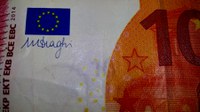EuroCrash - the catastrophy lurking ahead for the Euro
The Euro has been designed according to the principles of fiat money, which, in general, makes sense. However this works only in conjunction with the principles of Soziale Marktwirtschaft which from here on we will call Chained Capitalism. Chained Capitalism is correctly characterized by well-ordered, well-regulated markets. They lay its foundations. In public opinion, the chained capitalism is often equated with a welfare state. However, a chained capitalism is controled by law and market order, which enables even smaller market participants a fair share, fair play. Cut-throat competition is ruled out. At the same time this guarantees that no enterprise or person gains so much market power that they can manipulate the political decision making process by their political power. If they gain too much political power, they can lobby for too much unfair advantage at the expense of the common good by changing the rules of the game. On the other hand, a true chained capitalism offers well-ordered and well-regulated markets preventing these pitfalls of market economy and keeping the factors of production, land, labour and capital in equilibrium. Thus all citizens can sustain themselves from the land (e.g., the peasant), from labour (a worker, an employee, the self-employed, entrepreneurs) or from their saved capital and live together in harmony. Politics maintains the stability of this system in order to promote and increase the common good for the citizens. However, liberalized, deregulated markets remove order and the rule of law. This yields to anarchy and subsequently to the rule of "might is right" instead of the rule of law. It promotes further greed, a gambler mentality which leads to a dangerous concentration of (market) power and money. This in turn enables successful lobbying, leading to even more (market) power. And so the spiral continues.
In older, capped money systems the volume of money was limited by, for example, relating it to the available stock of gold. In the past, t hat led to a lack of money for most going hand in hand with increasing market power and money concentration in the liberalized markets in favour of a few. Consider a lonely island where the four inhabitants originally possess the same amount of money. One of them saved everything, but the other three spent all they had. This meant that the saver got all the money. From then on, the saver, as an entrepreneur, did not invest any of his or her money, because there would have been no demand from the other three. The saver did not lend them anything, because they had nothing of interest left for him or her. There are similarities in an economy with a limited, "capped" money supply: if a few scrooges hoard the money, the many will not have money to supply their own needs. Therefore, the demand will go down, followed by a decrease in investments, entrepreneunerial profit, and labour, resulting in an even more unequal distribution of wealth and income. This downward spiral goes on and on. The real economy comes to a standstill. Either the private households and/or corporations get into debt, or general government takes over in order to enable the economy to grow. In history, the alternative has usually been famine, war or revolution. Although capped money systems are no longer widespread, they are still maintained by some countries.
hat led to a lack of money for most going hand in hand with increasing market power and money concentration in the liberalized markets in favour of a few. Consider a lonely island where the four inhabitants originally possess the same amount of money. One of them saved everything, but the other three spent all they had. This meant that the saver got all the money. From then on, the saver, as an entrepreneur, did not invest any of his or her money, because there would have been no demand from the other three. The saver did not lend them anything, because they had nothing of interest left for him or her. There are similarities in an economy with a limited, "capped" money supply: if a few scrooges hoard the money, the many will not have money to supply their own needs. Therefore, the demand will go down, followed by a decrease in investments, entrepreneunerial profit, and labour, resulting in an even more unequal distribution of wealth and income. This downward spiral goes on and on. The real economy comes to a standstill. Either the private households and/or corporations get into debt, or general government takes over in order to enable the economy to grow. In history, the alternative has usually been famine, war or revolution. Although capped money systems are no longer widespread, they are still maintained by some countries.
In a market economy, even a chained capitalism, there will always be an unfair distribution, in other words, misallocation, of income and property. For that reason, the fiat money system was invented. The money system of fiat money is not coupled to commodities such as gold, which would mean that the money supply could only grow by mining more gold. Instead, the money supply is coupled to economic growth (gross national product, GNP). Thus there is, in principle, fresh money available for new economic activities despite the fact that the existing money supply is being hoarded by a few. The creation of new money is acceptable if it reflects real economic performance. In this way, general welfare can be increased. In our fiat money system (Euro, today's US-Dollar) this is achieved by allowing the creation of new debt through a loan of money by a commercial bank. The money supply increases according to the amount of credit. The balance sheet total increases on both sides accordingly for the same amount. Bank money is created, constituted of bits and bytes, but is nevertheless convertible to cash. If a loan is paid off, the balance sheet will be decreased on both sides by the amount of money being paid off. While the balance sheet is being shortened again, the corresponding amount of money is removed from the economic cycle, that is. it is destroyed again. The loan could be used for investment, consumption or other activities and thus increases  economic performance in quantity, that is, it could create labour and welfare. A challenge appears if the loan cannot be paid off. Then the amount of money not paid off would stay in the economic cycle and put pressure on the system, because additional interest would have to be paid. Approximately 95 % of all loans are given in this fashion creating an additional money supply, only around 5% of loans are being taken directly from saved money, without increasing the money supply.
economic performance in quantity, that is, it could create labour and welfare. A challenge appears if the loan cannot be paid off. Then the amount of money not paid off would stay in the economic cycle and put pressure on the system, because additional interest would have to be paid. Approximately 95 % of all loans are given in this fashion creating an additional money supply, only around 5% of loans are being taken directly from saved money, without increasing the money supply.
An even greater challenge arises when the chained capitalism is given up in favour of a capitalistic, supply-side economy with liberalized, deregulated financial markets. This has happened since the 1980s and was especially promoted by the political initiatives of former US President Reagan and former British Prime Minister Margaret Thatcher.
The supply-side theory has established itself fully on both sides of the Atlantic Ocean, bringing with it liberalized, deregulated markets, especially financial markets. This has occurred with an obvious lack of awareness of its catastrophic interdependence with the fiat money system which we will outline below. After the Treaty of Maastricht in the year 1992 the economic policy of the European Union was fully based on supply-side theory with liberalized markets. The emerging so called free trade agreements TTIP and CETA are based on the same fundamentally flawed foundations. Why is it that this design is fundamentally flawed?
To answer this question, we need to consider the consequences of liberalized markets operating within a Fiat system. We acknowledge that fiat money does offer a useful advantage for stimulating real economic performance. With this system, a new money supply is created and can be obtained. It is important, however, that money creation is tied to real economic activities. Only in this way does the newly created money have a counter value. And only by this means of money creation does the money system avoid destruction.
Money hoarding by a few scrooges destroys the possibility of sufficient demand. By promoting real economic growth through creating additional money, the fiat money system is able to prevent this.
 However, this works only if the newly created money supply goes into the real economy and is, at least in principle, only created under these conditions. Within our current supply-side economy with liberalized financial markets, however, there will be higher returns on the rampant, deregulated financial markets than in the real economy. Therefore, the newly created money will not be used for real economic activities, but for hazardous bets on the financial markets. This results in an increase in the money supply that is not related to an increase in welfare. The money is not used for the production of goods and services. Despite the increase in money supply, there is no inflation, in contrast to the predictions of the so-called money theorists (monetarists). This results in a loss of the preconditions for a fully functional fiat money monetary system, the coupling of a real creation of value and creation of money. By funnelling the newly created money supply into the financial markets but not into the real economy, we end up in a scenario which is well known from capped money systems: the ill-distribution, the misallocation of income and enormous increase of wealth for some through the nurturing of huge financial bubbles. As in the capped money system, all this ends in deflation caused by the lack of money supplies for the real economy. The masses have no money, and therefore the prices for goods and services decrease. The aggregate demand for goods and services decreases, because the return on speculative offers on the financial markets steadily increases. The money moves into the pockets of opportunist investors and is divested from the real economy. As the return on the financial markets increases, more financial bubbles are being nurtured. Inflation will not occur, because the money does not move into the real economy. It can only occur from demand for real goods and services. As a result, there is even less income in the real economy, less investment, and less consumption. The prices continue to decrease, and the misallocation of income and wealth escalates. The real economy, the foundation of any monetary value, is disrupted.
However, this works only if the newly created money supply goes into the real economy and is, at least in principle, only created under these conditions. Within our current supply-side economy with liberalized financial markets, however, there will be higher returns on the rampant, deregulated financial markets than in the real economy. Therefore, the newly created money will not be used for real economic activities, but for hazardous bets on the financial markets. This results in an increase in the money supply that is not related to an increase in welfare. The money is not used for the production of goods and services. Despite the increase in money supply, there is no inflation, in contrast to the predictions of the so-called money theorists (monetarists). This results in a loss of the preconditions for a fully functional fiat money monetary system, the coupling of a real creation of value and creation of money. By funnelling the newly created money supply into the financial markets but not into the real economy, we end up in a scenario which is well known from capped money systems: the ill-distribution, the misallocation of income and enormous increase of wealth for some through the nurturing of huge financial bubbles. As in the capped money system, all this ends in deflation caused by the lack of money supplies for the real economy. The masses have no money, and therefore the prices for goods and services decrease. The aggregate demand for goods and services decreases, because the return on speculative offers on the financial markets steadily increases. The money moves into the pockets of opportunist investors and is divested from the real economy. As the return on the financial markets increases, more financial bubbles are being nurtured. Inflation will not occur, because the money does not move into the real economy. It can only occur from demand for real goods and services. As a result, there is even less income in the real economy, less investment, and less consumption. The prices continue to decrease, and the misallocation of income and wealth escalates. The real economy, the foundation of any monetary value, is disrupted.
These kinds of obnoxious economic policies have created enormous increases in money supply to the economic cycle, especially after the crash in 2008. The money was not burned - as politicians have wanted the public to believe - instead, it went into third parties bank accounts somewhere else. Because the loans defaulted and the debtors became unable to pay their debt, the money remained in the economic cycle, since it could not be charged off by redemption. To avoid a crash of the Euro, the bad, defaulted loans were secured by general government. Thus became theoretically possible to pay off the loans and remove them from the economic cycle. However, this means they were and, in the future will be paid off at the expense of the general public, inviting even more invidious high risk business dealings. Debts were being socialized while gains were being privatized.
A fundamental error of economic and monetary policy is being committed by running the fiat money system of the Euro (and the Dollar) together with a supply-side economy with liberalized, deregulated markets. This is the most fatal of all mistakes. It leads the Eurozone of the European Union into ruin and will bring about the end of the Euro.
In their book, "Soziale Marktwirtschaft statt Kapitalismus - Von der Volkswirtschaft und vom Gelde" Oppitz and Weigele not only describe these interdependencies in detail, but also indicate possible solutions.
Politics is urgently required to correct the fundamentally flawed economic bias. Only a chained capitalism with regulated production factors, and in particular regulated financial markets, is able to re-establish welfare for all and strengthen democracy.
The authors therefore demand a return to the Fiat Money System in conjunction with a Chained Capitalism. This is explained in detail in their book in the German language:
- Reiner Oppitz und Martin Weigele, „Soziale Marktwirtschaft statt Kapitalismus – Von der Volkswirtschaft und vom Gelde“, BoD-Verlag, November 2014, 408 Seiten. Available as
Document Actions
